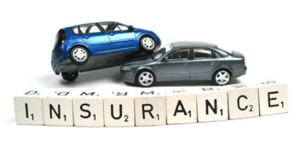Car Insurance 101
 Getting car insurance for the first time can be intimidating. It’s easy to feel like
a small fish in a big ocean swimming your way through jargon, rhetoric, options, expenses,
rules, and on and on. How are you ever going to make heads or tails of it all and
find the best car insurance for your situation? As unpleasant as it may seem, auto
insurance is required by law and it can save your butt (and your bank account) when
it comes to accidents and the unexpected. Because let’s be honest, when it comes down
to it, paying the full cost of an unexpected accident by yourself is a whole lot more
unpleasant than only paying for part of it.
Getting car insurance for the first time can be intimidating. It’s easy to feel like
a small fish in a big ocean swimming your way through jargon, rhetoric, options, expenses,
rules, and on and on. How are you ever going to make heads or tails of it all and
find the best car insurance for your situation? As unpleasant as it may seem, auto
insurance is required by law and it can save your butt (and your bank account) when
it comes to accidents and the unexpected. Because let’s be honest, when it comes down
to it, paying the full cost of an unexpected accident by yourself is a whole lot more
unpleasant than only paying for part of it.
So where to begin? First, it’s important to understand the five basic kinds of insurance that all insurance companies offer.
Check out this video for help understanding the types of auto insurance coverage: https://www.youtube.com/watch?v=-Zr63hTicTU
- Liability Coverage (or Bodily Injury Coverage): This is definitely the most common kind of coverage mostly just because most states require a certain amount of it. It’s simple, liability coverage pays for the damages you are liable for or which you are responsible for in an accident. That means damage to another person’s vehicle and/or their medical expenses as well. The cool thing is that if you are in an accident that is not your fault, the other person’s liability coverage will cover any damages to your car or for any injuries you received from the accident.
- Collision Coverage: This kind of coverage pays for any kind of crash related damages to your car (even when you’re at fault). This can mean a collision with another car or other things like light poles, trees etc.
- Comprehensive Coverage: This coverage is kind of like collision coverage but it covers things that are out of your control like natural disasters, fire, hitting an animal, theft or vandalism. These are things that there’s no way you could have controlled or predicted, hence comprehensive coverage- or coverage good for a variety of and a comprehensive set of situations. It’s usually a pretty good choice for new or expensive cars.
- Personal Injury Protection or “No-Fault” Coverage: In some states this coverage is sometimes required along with liability coverage. It pays for your medical expenses even if the accident was your fault. That’s why it’s sometimes called “No-Fault” coverage- because it doesn’t matter who was at fault, it will still cover you.
- Uninsured/Underinsured Coverage: This coverage protects you from the risk of being in an accident with someone who doesn’t have insurance or who doesn’t have enough to pay for the expenses of the accident. So say you were in an accident with someone, it was their fault, but you find out that they don’t have any insurance- no liability coverage to take care of the damage to your car and/or your injuries. Uninsured coverage would take of that for you. Or, say you were in a similar accident but the cost of damages were so much that the other person’s insurance couldn’t cover it. That’s when your Underinsured Coverage would kick in and take care of it.
 Alright, so you understand that there are different kinds of coverage you can choose
from- sweet! So now what can you expect insurance companies to ask for in return?
What are you going to have to pay for these coverages?
Alright, so you understand that there are different kinds of coverage you can choose
from- sweet! So now what can you expect insurance companies to ask for in return?
What are you going to have to pay for these coverages?
Ever heard of “premiums” or “deductibles”? Let’s make it simple. A premium is the amount you have to pay for a specific kind of coverage for a specific amount of time. In easy language, it’s just how much you pay usually on a monthly basis for your insurance.
A deductible is the amount you agree to pay before your insurance company will begin paying for the costs of an accident. So for example, if your deductible is $500 and you are in an accident that costs $4500, you will have to pay your $500 deductible before your insurance company will pay the remaining $4000.
Now, there’s good news and there’s bad news. Premiums and deductibles are related, that’s the good news. But sometimes the way they affect each other can be complicated and confusing. Usually if you decide to pay a higher deductible, your premium rates will be lower. But, you’ll have to pay more out of your pocket if you do end up having an accident. If you go with a lower deductible, then your premiums will end up being higher, but in the case of an accident your insurance company will pay for more of the cost.
So what about you? What kind of coverage should you get and how are you going to know? This is a great question and one that can be answered with those two detestable words…. it depends. There are a lot of things that can go into deciding what kind of auto insurance is best for you. For example, you should take into consideration the kind of car you have- is it an old beater or is it a collectible inherited from your rich Uncle Bob? If your car is very valuable, you’ll probably want some coverage that allows you to protect it from unpredictable risks like theft (e.g. Comprehensive Coverage). You should also think about what you will be using your car for– is it essential to your morning commute and daily routine or will you use it mostly for fun? If you plan on using your car a lot it’s good to know that the higher your mileage is the higher your premium rates can be too. Another good thing to remember is that the more you use your car, the more chance you have of getting into an accident. Because your risk of an accident goes up, you might want to consider more kinds of coverage to cover the various kinds of risk (think Collision Coverage and even Uninsured/Underinsured Coverage). In short, taking an assessment of your car and the ways you use your car can help you decide the kind of auto insurance to go with. Remember, insurance is there to protect you from the risk of accidents, so trying to plan and prepare for potential accidents you could have as well as the kind of expenses you want to avoid is a good way to guide your insurance selection.
 Last but not least, it’s probably a good idea to find out what other people are doing
for their auto insurance. What are the most popular auto insurance companies out there?
Here’s what the Wall Street Journal has to say about finding car insurance companies:
Last but not least, it’s probably a good idea to find out what other people are doing
for their auto insurance. What are the most popular auto insurance companies out there?
Here’s what the Wall Street Journal has to say about finding car insurance companies:
“Once you’ve decided how much car insurance you need, it’s time to begin shopping. Auto insurance policies vary widely depending on your car, your driving record and your credit, so it’s wise to do some research.
Go toinsweb.com andInsurance.com and fill out the application form. After a short time, you’ll receive comparable quotes from several insurers. There are three kinds of insurers:
Direct sellers – You’re likely familiar with these brand names, such asGEICOs andProgressive. These companies sell coverage directly to you, bypassing traditional insurance agents. Since there’s no agent, there’s no commission; theoretically the savings are passed on to you. But these insurers accept only the best drivers, so you may have trouble qualifying for coverage if you have a history of accidents or moving violations.
Large national brands –Allstate andState Farm are better equipped for drivers with a bit of a blotchy past, and their rates are usually pretty good (they may even be able to match some of the offers from the direct sellers). These companies sell through local agents, but their agents are exclusive—a State Farm agent sells State Farm coverage and nothing else, so you’ll have to do your own comparison shopping.
Independent insurance agents – These sellers offer all kinds of insurance from many different companies. If you have any issues affecting your ability to get coverage (such as a patchy driving record or a teenage driver in your house) independent agents can usually find you better coverage at better prices than what you’d find on your own. Ask friends and family whether they have an insurance agent they would recommend.”
(http://guides.wsj.com/personal-finance/insurance/how-much-car-insurance-do-you-need/)
Long story short, getting car insurance might be a bit of a process but it’s worth the effort. Check out the links below for more information!!
5 factors that affect your premium rates
- deductible
- mileage
- kind of car (expensive etc)
- driving record (traffic tickets, DUI’s)
- personal information (gender, age, married status)
https://www.youtube.com/watch?v=5lG7RKbPbq8
Insurance coverages required in Utah:
- bodily injury
- physical damage liability
- personal injury protection
More resources:
How To Read Your Policy Declarations: https://www.lelandwest.com/how-to-read-your-policy-declarations.cfm
About the Blog
The Financial Wellness Center's discussion channel for insightful chat about our events, news, and activities.
